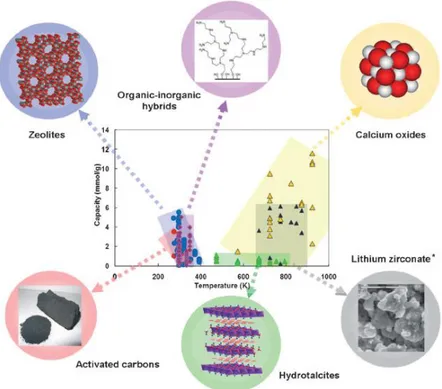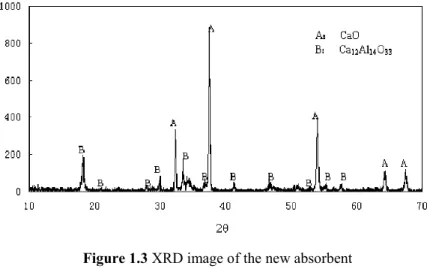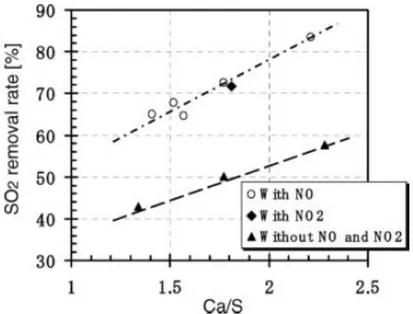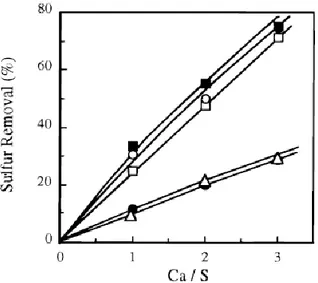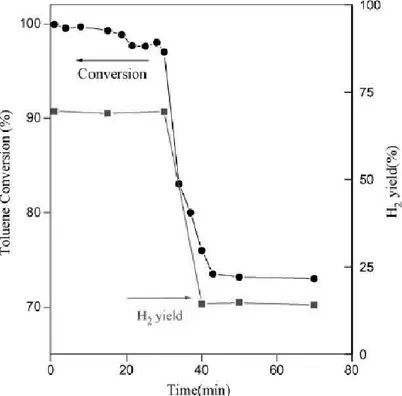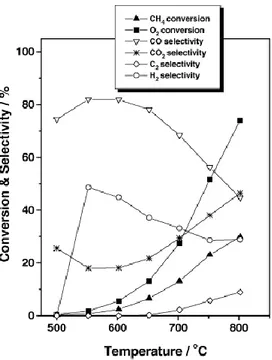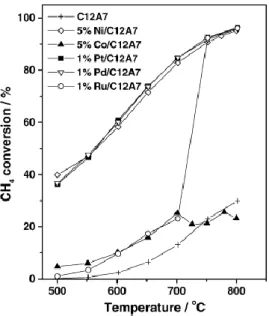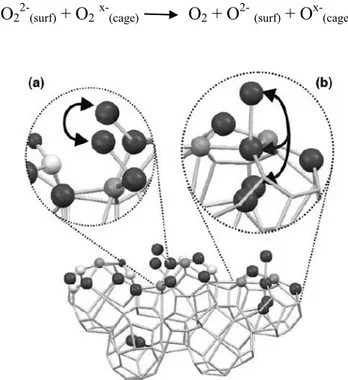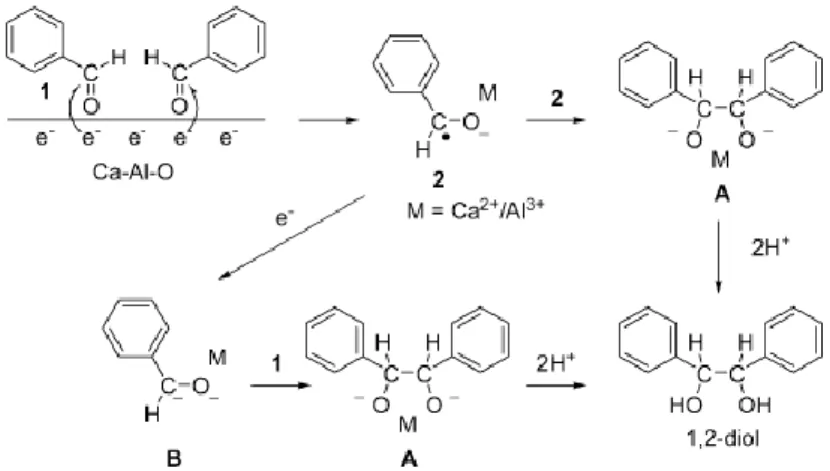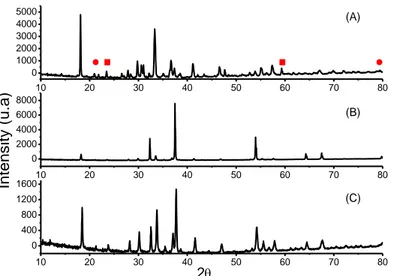1
University of Salerno
Department of Chemistry and BiologyPh.D Course in Chemistry (XIII Cycle)
ENVIRONMENTAL AND CATALYTIC APPLICATIONS OF ALKALINE OXIDES
Supervisor Ph.D Student
Prof. Antonio Proto Raffaele Cucciniello
Co-Supervisor
Prof. Leone Oliva Prof. Oriana Motta
Scientific referee
Prof. Vincenzo Venditto
Ph.D Course Coordinator
Prof. Gaetano Guerra
3
Publications
- R.Cucciniello, A.Proto, D. Alfano, O. Motta. Synthesis, characterization and field evaluation of a new based-Ca CO2 absorbent for radial diffusive sampler, Athmospheric Environment 60, (2012), 82-87
- R.Cucciniello, A.Proto, F. Rossi, O. Motta. Mayenite based supports for atmospheric NOx sampling, Athmospheric Environment 79, (2013),666-671
- A.Proto, R.Cucciniello, F. Rossi, O. Motta. Stable carbon isotope ratio in atmospheric CO2 collected by new
diffusive device, Environmental Science and Pollution
Research, 21 (4),(2014), 3182-3186
- A.Proto, R.Cucciniello, F. Rossi, O. Motta. Ca-based absorbents for NOx measurements in atmospheric
environments surrounding monumental and archeological sites, Procedings of conference Built Heritage 2013 – Monitoring conservation and management, pag.1447-1453, ISBN 978-88-908961-0-1
- O. Motta, R. Cucciniello, C. Scicali, A. Proto. A study on the applicability of zinc acetate impregnated silica substrate in the collection of hydrogen sulfide by active sampling, Talanta, 128, (2014), 268-272
- O. Motta, I. Zarrella, R. Cucciniello, G. Vigliotta, A. Proto. Study of the antibacterial activity in the gas phase of a chemical formulation for the household waste management, Letters in Applied Microbiology, accepted for publication
- A. Proto, R. Cucciniello, A. Genga, C. Capacchione. A study on the catalytic hydrogenation of aldehydes using mayenite as active support for palladium, Catalysis
4
Congress presentations
- A.Proto R.Cucciniello, C. Ardovino,O. Motta. The determination of atmospheric CO2 by a passive sampling
device. Proceedings of Urban Environmental Pollution, 14-17 june 2012, Amsterdam, The Netherlands
- R.Cucciniello, A.Proto, F. Rossi, O. Motta. Sviluppo di substrati inorganici a base di ossidi metallici per la determinazione simultanea di NO e NO2 con campionatori
passivi. Proceedings of XIII Congresso Nazionale di
Chimica dell’Ambiente e dei Beni Culturali, 10-14
september 2012, Taranto, Italy
- O. Motta, F. De Caro, E. Santoro, L. Palmieri, C. Ardovino, G. Boccia, P. Cavallo, R.Cucciniello, A.Proto, M. Capunzo. Alternative al CS2 per l’estrazione di BTEX
da substrati a base di carbone attivo, Proceedings of 45°
Congresso Nazionale SITI, 3-6 october 2012,Cagliari,
Italy
- R.Cucciniello, A.Proto, F. Rossi, O. Motta. Nuovo substrato per il campionamento attivo di acido solfidrico in atmosfera, Proceedings of XIV Congresso Nazionale di
Chimica dell’Ambiente e dei Beni Culturali, 2-5 june
2013, Rimini, Italy
- R.Cucciniello, F. Rossi, O. Motta, A.Proto. NOx uptake on
Ca-based absorbents”, Proceedings of International
Conference on Chemistry and the Environment 2013,
25-28 june 2013, Barcellona, Spain
- R.Cucciniello, C. Capacchione, O. Motta, A.Proto. Interaction between NOx and Ca-based sorbents, Proceedings of XLI Congresso di Chimica inorganica, 3-6
5
- R.Cucciniello, C. Capacchione, O. Motta, A.Proto. Catalytic aldehyde reduction in the presence of nanoporous calcium aluminate, Proceedings of XLI
Congresso di Chimica inorganica, 3-6 september 2013,
Parma, Italy
- A.Proto, R.Cucciniello, F. Rossi, O. Motta. Ca-based absorbents for NOx measurements in atmospheric
environments surrounding monumental and archeological sites, Proceedings of Built heritage, 18-20 november 2013, Milan, Italy
- R. Cucciniello, C. Pironti, C. Capacchione, O. Motta, M. Di Serio, A. Proto. Efficient conversion of glycidol to value-added products using heterogeneous catalysts, Proceedings of 5° Euchems Chemistry Congress, 31 August-4 September 2014, Istanbul (Turkey)
- R. Cucciniello, O. Motta, F. Esposito, F. Rossi, A. Proto. A new substrate for the active determination of hydrogen sulfide in air, Proceedings of 5° Euchems Chemistry Congress, 31 August-4 September 2014, Istanbul (Turkey) - F. Rossi, A. Intiso, R. Cucciniello, O. Motta, N. Marchettini, A. Proto. A new technique for the determination of trichloroethylene diffusion matrix in water, Proceedings of XXV Congresso della Società
Chimica Italiana, 7-12 September 2014, Rende, Italy
- R. Cucciniello, C. Pironti, C. Capacchione, M. Di Serio, A. Proto. Heterogeous catalysts for the production of glycols from glycerol derivates, Proceedings of XXV
Congresso della Società Chimica Italiana, 7-12
September 2014, Rende, Italy
- R. Cucciniello, I. Zarrella, F. Rossi, O. Motta, A. Proto. Antibacterial chemical formulation for the household waste management, Proceedings of XXV Congresso della
6 Società Chimica Italiana, 7-12 September 2014, Rende,
Italy
- R. Cucciniello, C. Pironti, C. Capacchione, M. Di Serio, A. Proto. Catalytic materials for the hydrogenation of glycidol to value-added products, Proceedings of XXV
Congresso della Società Chimica Italiana, 7-12
September 2014, Rende, Italy
- R. Cucciniello, O. Motta, A. Proto. BTEX extraction from activated charcoal using dichloromethane as alternative to carbon disulfide, Proceedings of the 1st VDI Expert Forum
on Atmospheric Chemistry, 19-20 November 2014, Bonn,
7 Table of contents Index of figures 9 Index of tables 11 List of abbreviations 12 Abstract 13 Introduction 14 Chapter I
Employment of Ca-based sorbent in industrial and environmental field
1.1 Materials for CO2 capture from anthropogenic sources 19 1.2 Carbon dioxide adsorption capacities of CaO 22
1.3 NOx uptake on alkaline earth oxides 26 1.4 Desulfurization processes using Ca-based sorbent 30
References 34
Chapter II
Catalytic applications of alkaline oxides: The history of Mayenite (Ca12Al14O33)
2.1 Mayenite (Ca12Al14O33): structure and properties 35 2.2 Mayenite as active catalyst support: an overview 38
2.3 Ammonia synthesis using a stable mayenite electride as
support for ruthenium 44
8
Chapter III
Experimental part
3.1 Development of Ca-based sorbents for atmospheric NOx sampling
3.1.1 Preparation of CaO/Ca12Al14O33 substrates 51
3.1.2 Substrates characterization 52
3.1.3 NOx sorption experiments 54
3.1.4 Thermal analysis 55
3.1.5 Infrared characterizazion of the material after the exposure to NOx 58 3.1.6 Ion chromatographic quantification of NOx 63 3.1.7 Passive device preparation and preliminary field evaluation 66
3.1.8 Conclusions 73
References 74
3.2 CO2(g) sorption on CaO/Ca12Al14O33 substrate for carbon isotope
ratio analysis
3.2.1 CO2 sorbent material preparation 75
3.2.2 CaO/Ca12Al14O33 characterization 76
3.2.3 Field measurements 77
3.2.4 Carbon isotope ratio analysis and evaluation of possible isotopic
fractionation 79
3.2.5 Conclusions 86
References 87
3.3 Use of mayenite as active support in catalysis
3.3.1 Preparation of mayenite based catalysts 88
3.3.2 Catalysts characterization 89
3.3.3 Hydrogen sorption experiments 97
3.3.4 Aldehydes hydrogenation reactions 99
3.3.5 Conclusions 107
References 108
Conclusion Appendix A
Project “Dottorati in azienda” in collaboration with Cle.Pr.In srl 110
9
Index of figures
Figure 1.1 CO2 sorbent materials. Figure 1.2 CO2 absorbent preparation.
Figure 1.3 XRD image of the new absorbent CaO/Ca12Al14O33 (75/25%wt).
Figure 1.4 Carbonation/calcination cycles of CaO/Ca12Al14O33. Figure 1.5 SO2 removal using Ca-based sorbent.
Figure 1.6 Effect of Ca/S molar ratio on sulfur removal.
Figure 2.1 Part of the crystal structure of mayenite viewed from the
<111> direction.
Figure 2.2 Toluene conversion and H2 yield vs time on Ni/Mayenite 5% wt at 800°C.
Figure 2.3 Conversion and selectivity of methane partial oxidation to
syngas over mayenite.
Figure 2.4 CH4 partial oxidation to syngas over unpromoted and promoted mayenite as a function of temperature.
Figure 2.5 Suprafacial (a) and intrafacial (b) recombination of oxygen
atoms produced upon dissociation of N2O.
Figure 2.6 Crystal structure of the C12A7 electride. Figure 2.7 Ru/Mayenite electride catalyst.
Figure 2.8 Pinacol coupling reaction promoted by mayenite electride. Figure 2.9 Mechanism of pinacol coupling promoted by C12A7:e-. Figure 3.1 X-Ray diffraction patterns of (A) mayenite; (B) CaO/Mayenite 75:25 w/w and (C) CaO/Mayenite 35:65 w/w. Symbols in panel (A) reveal the presence of two spurious phases in the structure of mayenite, namely Ca3Al2O6 and CaAl2O4.
Figure 3.2 Thermograms of three different samples of sorbent materials
after the hydration process in a closed system. Mayenite; CaO/Mayenite 35:65 w/w; CaO/Mayenite 75:25 w/w.
Figure 3.3 FTIR spectra of unhydrated CaO/Mayenite substrates after NO
and NO2 adsorption at 298K .
Figure 3.4 FTIR spectra of hydrated CaO/Mayenite substrates after NO and NO2 adsorption at 298K.
Figure 3.5 FTIR spectra of hydrated Ca12Al14O33 after NO and NO2 adsorption at 298K.
Figure 3.6 RING assive sampler (Aquaria srl). Figure 3.7 Thermogram of carbonated substrate.
Figure 3.8 Thermogram of fresh CaO/Ca12Al14O33 sorbent. Figure 3.9 CO2 mass uptake profile versus time.
10
Figure 3.10 Experimental set-up. Figure 3.11 δ13C versus 1/[CO
2] concentration diagram (Keeling plot) of the different areas investigated.
Figure 3.12 Correlation between values obtained by the passive devices
and the NDIRS measurements.
Figure 3.13 XRD pattern of (A) 1% wt Pd/Mayenite and (B) pure
mayenite.
Figure 3.14 N2 adsorption-desorption isotherm of mayenite.
Figure 3.15 SEM images of (A) mayenite and (B) Pd/mayenite.
Magnification: 2kx (left column), 10Kx (right column).
Figure 3.16 Map of Pd distribution in the area shown in figure 4.15 at
10Kx and EDS spectra of the regions I and II in the dotted areas.
Figure 3.17 Transmission electron micrograph of 1% wt Pd/Mayenite. Figure 3.18 Hydrogen sorption profile of mayenite at 25°C.
Figure 3.19 1H-NMR of mayenite hydride.
Figure 3.20 Benzaldehyde conversion using Pd/Mayenite and Pd/C as
catalysts.
Figure 3.21 SEM image (A) and relative map of Pd distribution of sample
with Pd concentration of 10% (B).
Figure A1. Chromatogram of the mixture(2-propanol(1), limonene(2),
propylen glycol(3) and trans-cinnamaldehyde(4) ) obtained under working conditions.
Figure A2. Variation of composition of vapour phase of antimicrobial
mixture during the weeks.
Figure A3. Effect of antimicrobial mixture in liquid phase on Escherichia coli as a function of concentration.
Re gio n II region I
11
Index of tables
Table 3.1 Chromatographic analyses of freshly prepared sorbent materials
(nitrates blanks and LOD).
Table 3.2 Chromatographic analyses of Mayenite exposed to NOx. Table 3.3 Chromatographic analyses of CaO/Mayenite exposed to NO. Table 3.4 Chromatographic analyses of CM75 in field experiments. Table 3.5 BET surface area analysis.
Table 3.6 Effect of time and temperature on benzaldehyde conversion. Table 3.7 Effect of time on selectivity using Pd/C at 120°C.
Table A1. Reagent composition of antimicrobial mixture.
Table A2. Antimicrobial effect of mixture’s vapour phase during the
weeks. The number of CFU is considered n.c. when they were not countable for the presence of a high density of colonies.
12
List of abbreviations
IC: Ion chromatography
FT-IR: Infrared analysis using Fourier transform TGA: Thermogravimetric analysis
XRD: X-ray diffraction
PM: Pure Mayenite (Ca12Al14O33)
CM75: CaO/ Ca12Al14O33 75:25 wt%
CM35: CaO/ Ca12Al14O33 35:65 wt%
LOD: Limit of detection NOx: Nitrogen oxides
GC-FID: Gas chromatography with flame ionization detector EO: Essential oils
MIC: Minimum inhibitory concentration CFU: Colony forming unit
CO2: Carbon dioxide
C12A7: Ca12Al14O33; mayenite
C12A7:H: Ca12Al14O33 doped with H-
C12A7:e-: Ca12Al14O33 doped with e-
Ru: Ruthenium HCl: Chloridric acid
13
Abstract
Alkaline oxides are widely used in industrial processes involving removal of gaseous compounds as unwanted by-products such as CO2, hydrogen sulphide and nitric oxides.
Traditional processes generally involve Ca-based sorbents for their high performances also at high-temperature, high availability, low costs and good recyclability in subsequent adsorption/desorption cycles.
Recently, interest about the use of new alkaline oxides in catalysis has increased considerably due to extraordinary discovery of an high active metal oxide namely mayenite, Ca12Al14O33, able to take active part in catalytic reactions such
as biomass steam reforming and nitrous oxide removal from the process gas of nitric acid plants.
Based on high reactivity of Ca-based sorbents towards gaseous acidic molecules, the first part of this thesis is dedicated to the employment of Ca-based sorbents in environmental devices, passive samplers, in order to evaluate their applicability as CO2 and NOx sorbents.
Moreover, the use of Ca12Al14O33 as active support in
catalysis is investigated in hydrogenation reactions comparing activity in terms of conversion and selectivity with those of commercial catalysts.
14
Introduction
The main aim of this thesis is to evaluate the applicability of Ca-based materials, particularly CaO and Ca12Al14O33, as
sorbents for atmospheric pollutants in passive sampling devices. Moreover, Ca-based materials are also used and tested as active support for palladium in the catalytic hydrogenation of aldehydes.
Passive samplers, initially developed and used for workplace air, have been found to be useful and cost-effective alternatives to conventional pumped samplers for monitoring ambient, indoor and personal exposures at low concentrations of analyte. In particular, passive samplers have been recognized as a valuable tool in environmental monitoring when the average, instead of the real time, pollutant concentration is the object of the monitoring. Respect to active samplers, passive ones can easily provide the measurement of time-weighted average (TWA) concentration which represents a fundamental part of the ecological risk assessment for chemical stressors. In contrast to active samplers where air is brought into contact with a detector or collector device by means of a pump, passive samplers depend on diffusion process which allows the interaction of the pollutant with the collector. Diffusion driving forces and separation mechanisms are based on the difference in the
15 chemical potentials of trapped and non-trapped analytes. In particular, diffusive sampling relies on the principles of Fick’s first law which can be expressed as J= D/l(1 - 2)
where J = diffusive flux, D = diffusion coefficient of analyte, l = length of static air layer in the sampler, 1 = concentration
of the given analyte at the beginning of the diffusion layer (l=0) and 2= concentration of the given analyte at the end of
the diffusion layer.
The thesis is organized in the following sections.
Chapters 1 and 2 briefly describe applications of Ca-based materials in industrial processes and catalytic reactions. In Chapter 3.1 is reported the synthesis and characterization of a new class of calcium based sorbent materials for the quantification and possibly the removal of NOx from the
atmosphere. Particularly, various CaO/Mayenite (Ca12Al14O33) substrates having different weight ratio (w/w)
composition, were synthesized and characterized. Their reactivity towards NO and NO2 was evaluated by means of
several experimental techniques: FT-IR and XRD were used to characterize the species formed during the sorption process, whereas IC and TGA analysis provided information about the dynamics of the sorption process itself. The hydration reaction occurring on the substrate before NOx sorption has also been
16 CaO/mayenite materials in field measurements by incorporating the substrate in a passive sampler device were tested. The simultaneous sorption of atmospheric NO2 and
NO has been investigated and the role of the carbon dioxide in the NOx – CO2 exchange reactions has been assessed.
In Chapter 3.2 is reported, the analysis of the carbon isotope composition (δ13C) which was performed for the first time in different urban and extra urban environments on atmospheric carbon dioxide collected by means of a new passive calcium– aluminium oxide-based sampler device.
CaO/Ca12Al14O33 75:25 w/w was used to determine stable
carbon isotope ratios (δ13C) in the atmosphere, after atmospheric CO2 sampling. Stable carbon isotopes (δ13C)
have proven to be useful geochemical markers and were employed to study air pollution since the 1980s. The information on the isotopic composition of CO2, together with
standard analytical determination on its concentration, has been extensively used for characterizing the carbon dioxide atmospheric budgets and its biogeochemical origins. The isotopic composition of CO2 also provides a powerful tool for
assessing sources and sinks of carbon, at local, regional, and global scales. At the local scale, in particular, the isotopic composition of fossil fuel emissions has been used to trace back the fuel sources and distinguish them from the emissions
17 generated by the biological activity in the urban areas.
Field measurements were conducted in three environments characterized by different carbon dioxide sources. In particular, the environments under consideration were a rather heavily trafficked road, where the source of CO2 is mostly
vehicle exhaust, a rural unpolluted area, and a private kitchen where the major source of CO2 was gas combustion.
In Chapter 3.3 it is described the incorporation of H- anions into the mayenite framework under mild conditions compared to those reported in literature. Surprisingly mayenite hydrides without any metal loading was observed to be already active in the reduction of benzaldehyde to benzyl alcohol. Furthermore the loading of such active support with palladium resulted in an highly active and selective catalyst for the catalytic reduction of aldehydes. The evaluation of catalytic activity towards hydrogenation of benzaldehyde and cinnamaldehyde was explored giving intriguingly results in terms of activity and selectivity.
In conclusion, Appendix A is dedicated to the “Dottorati in azienda” project based on a brief research experience in Cleprin srl, a leader company in the production of detergents for professional use where an innovative chemical formulation was developed for household waste management.
19
CHAPTER I
1.1 Employment of Ca-based sorbent in industrial and
environmental field
1.1 Carbon dioxide capture from anthropogenic sources Carbon dioxide is the major contributor of greenhouse effect. To mitigate the greenhouse gas impact, it is important to sequester CO2 from fossil-fuel plants, which account for about
one-third of all anthropogenic CO2 emissions(1). Much of the
work concerned the separation of CO2 from methane for the
purification of natural gas(2). Several different approaches have been proposed to remove CO2 from flue gases on a large
scale(3), and selective adsorption or chemisorption on solids media are well known(4). Different materials have been prepared and tested as carbon dioxide sorbent(2). In Figure 1.1 a panoramic of some CO2 sorbent materials is reported.
20
Figure 1.1 CO2 sorbent materials.
The acidic nature of CO2 facilitates adsorption on the basic
sites of some metal oxides, especially those with a low charge/radius ratio. This group of materials includes alkaline metal oxides (Na2O, K2O) and alkaline earth metal oxides
(CaO, MgO) on which CO2 molecules can be adsorbed
forming mono or multidentate species. Particularly, calcium oxide has been widely used as sorbent for CO2 as reported in
literature(5,6). One mole of CaO reacts with a stoichiometric
equivalent of CO2 to form the correspondent carbonate
21 CaO(s) + CO2(g) CaCO3(s)
In large scale CO2 capture applications, these materials are
thought to be advantageous compared to other adsorbents on account of the low cost and wide availability of precursor such as limestone and dolomite(7).
1.2 Carbon dioxide adsorption capacities of CaO
Based on the stoichiometric carbonation reaction of CaO, the maximum theoretical amount of adsorbed CO2 is 17.8 mmol/g
but typical capacities reported in literature are lower than this value and also they are still higher than those of other inorganic chemisorbents(8). Barker demonstrated that CO2
adsorption capacities of calcium oxide powder varied with changes in particle sizes and surface areas (9). In addition, also the type and the composition of precursors influence the adsorption properties of calcium oxide-based adsorbents. Another important characteristic of CaO is its applicability in CO2 adsorption-desorption cycles at high temperature in
industrial processes. In fact, the reversible carbonation and decarbonation reactions of calcium oxide and CO2 to produce
CaCO3 provide an interesting approach for CO2 capture and
separation from high-temperature gas streams, such as flue gas and gas streams encountered in coal gasification, fuel cell
22 applications, and chemical heat pumps(10). Generally calcium oxide based adsorbents suffer from a rapid CO2 capture
capability during the repletion of carbonation/calcinations cycles due to pore blocking and adsorbent sintering. Experimental tests have demonstrated that the main factor for calcium oxide degradation was not adsorbent sintering but the blockage and collapse of the pore structure.
Extensive efforts have been made to enhance the stability of calcium oxide particulates by modifying their material properties, particularly, increasing surface area and preparing a more stable pore structure. The direction of this research can be categorized into four strategies: techniques using rigid supports, use of additives, preparation of nanoparticles and use of different synthetic precursors (5). The first method is based on the concept of employing a rigid porous material as carrier for the calcium oxide species. Feng (11) prepared CaO particles in an inert alumina support. In the second method, additives were incorporated in the calcium oxide precursors to improve the adsorbent stability by preventing sintering of the particles during the regeneration stage(12). The third technique is to reduce the particle size of the adsorbent down to the nanometer scale(13). Finally, the fourth technique is based on the use of new synthetic precursors that can produce adsorbent materials with a rich micropore structure(14).
23 Li and its collaborators have prepared a new kind of Ca-based regenerable CO2 absorbent, CaO/Ca12Al14O33, on the basis of
the integration of CaO, as solid reactant, with a composite metal oxide Ca12Al14O33, as a binder, to applying it to
repeated calcinations/carbonation cycles(15). The use of the composite metal oxide has significantly improved CO2
absorption capacity and cyclic reaction stability compared with other Ca-based absorbents. To prepare this new substrate authors propose a new interesting synthetic technique. High-reactivity absorbent is prepared mixing weighted amount of aluminium nitrate enneahydrate [Al(NO3)3*9H2O] and the
powder calcium oxide into a mixture of 2-propanol and water in order to obtain a material with CaO and Ca12Al14O33 weight
ratio of 75/25%. The mixture is stirred at 75°C and dried at 120°C before being calcined at 500°C in air. By this method, 2-propanol, water and nitric acid in the solution can be evaporated off in different stages, thereby offering the production of a fine porous powder. These particles are dried at 120°C and calcined in air at 800°C. From a mechanistic point of view the hydration and calcinations of CaO and aluminium nitrate consists of many physical processes and chemical reactions. When CaO is added into water, the reaction of hydration changes CaO into Ca(OH)2. The
24 Ca(OH)2 ultrafine particles with stirring at constant
temperature. The addition of 2-propanol makes the particle size distribution of the hydration product Ca(OH)2 more
uniform. When the sample is calcined at 500°C, Ca(OH)2
decompose to CaO. At the same time, aluminium nitrate begins to decomposes and generate Al2O3 according to the
following reaction:
4Al(NO3)3 2Al2O3 + 12NO2 + 3O2
The penetration of aluminium nitrate into particles enables more porosity during the process of decomposition of aluminium nitrate. When the sample is calcined at higher temperature, CaO and Al2O3 inside the particle react to
generate a new kind of material, Ca12Al14O33:
12CaO + 7Al2O3 Ca12Al14O33
Schematic diagram of hydration preparation of absorbent is shown in figure 1.2.
Figure 1.2 CO2 absorbent preparation.
25 and Ca12Al14O33 exist as shown in figure 1.3.
Figure 1.3 XRD image of the new absorbent
CaO/Ca12Al14O33(75/25%wt).
The new formed material during the cycles of carbonation/calcination acts as a binder and does not take part in the reaction and the absorbent shows a stable and high CO2
absorption capacity as shown in figure 1.4.
26 1.3 NOx uptake on alkaline earth oxides
The components of the polluting emission gases formed by the combustion of biomass and fossil fuels are mainly nitric oxide (NO) and nitrogen dioxide (NO2) which are collectively
named NOx. NO is the primary form in combustion products
(typically 95% of total NOx). NOx are the source of severe
environmental problems such as acid rain, smog formation, global warming, and ozone layer weakening. For the past 30 years, great efforts have been made in research directed to find solutions for the NOx problem. NOx is produced not only
by burning of fuels and biomass but also by lightening, oxidation of NH3 (produced by microbial decomposition of
proteins in the soil), and volcanic activity. Another nitrogen oxide that is relevant due to its important role in atmospheric pollution is N2O. It is produced mainly in the nature by
microbial activity. However, its level in the atmosphere continues to increase mainly due to anthropogenic activities. N2O is converted into N2 and NO in the stratosphere and it
contributes to the destruction of the earth’s protective ozone layer and to the green house effect.
Generally, two different approaches are considered to reduce NOx concentrations in atmosphere and its related
environmental problems such as acid rain, photochemistry smog, ecc. A first approach consists in modifying the
27 operational conditions to decrease the NOx formation. Among
new developed technologies, the furnaces with low production of NOx represent an important contribution. A
second approach consists in destroying or allowing NOx to
react with other reagents, making it possible to eliminate them or to modify them. Different material types are reported for the sorption of nitrogen oxides: some can adsorb NO or NO2
separately, but others can adsorb both of them. For reviewing, they were classified as follow: metal oxides, spinels, perovskites, zeolites, carbonaceous materials, and heteropolyacids. During the last forty years, several technologies were developed to control and diminish the NOx
emissions in the environment(16). Many alkaline earth metal oxides were synthesized and tested as NOx sorbents (BaO,
MgO, CaO, BaAl2O4, BaAl12O19). As an example, BaO was
tested to selectively react with NO2 through an intermediate
oxidation of NO catalyzed by noble metals (Pd and Pt), to yield nitrates as the final product(17). This system has been regarded as one of the most promising solution for the control of exhaust emissions in diesel engine devices. In order to evaluate possible interfering reactions with the sorption process, further experiments were performed to check the formation of parasite species like carbonates and sulphates, on the metal oxides surface(18). By following this approach,
28 nitrate species (bulk and surface nitrates) were characterized after the exposure of different metal oxides to NO2 and the
behavior of several alkaline earth oxides (SrO/γ-Al2O3,
CaO/γ-Al2O3 and MgO/γ-Al2O3) was investigated(19,20). The
amount of the sorbed NOx strongly depends on the sorption
mechanism as well as on the physical properties of the sorbents and the sorbates.
In 2005, Li (15) developed a new Ca-based material for the sorption of CO2 in industrial processes: CaO/Ca12Al14O33 was
obtained by integrating solid CaO with a composite metal oxide, Ca12Al14O33 (Mayenite), acting as the binder. Mayenite
is a nanoporous calcium aluminate prepared by calcination at about 1300°C of stoichiometric amount of calcium carbonate and alumina. Mayenite has an antizeolite-type structure with interconnected positively charged cages, which can host a variety of anionic species(21,22).
Recently, we succeeded in using CaO/Ca12Al14O33 as a solid
sorbent material in passive sampling devices for the determination of the atmospheric CO2(23). In this thesis I
present the synthesis of different substrates with variable weight ratio CaO/Ca12Al14O33, namely 75:25 w/w (CM75),
35:65 w/w (CM35) and pure mayenite (PM), capable to react simultaneously with NO and NO2. A simple and economic
29 characterized the reactivity of mayenite by investigating the influence of water surface sorption. Hydration phenomena were found to play an important role in the process of NOx
sorption and their subsequent conversion to nitrite and nitrate species. IR and TGA techniques were used to characterize the reaction products. A simple method to quantify the uptake of NOx is also devised, also taking into account the interference
of CO2 in environmental conditions. Finally I present a
possible application of the calcium oxide based sorbents for the simultaneous determination of atmospheric NO and NO2
30 1.4 Desulfurization processes using Ca-based sorbent
Coal-fired power generation will continue to play a key role in power supply because the estimated coal reserves are very large and the cost of coal is lower than that of other energy sources. In such scenario, SO2 emission from coal combustion
causes many serious problems. Wet, semi-dry and dry desulfurization processes have been found to be very effective for SO2 removal. Particularly, dry processes using Ca-based
adsorbents(25) have low costs, needs no water, and produces the valuable byproduct CaSO4. At the typical combustion
temperature, 800-900°C, CaO produced by CaCO3
decomposition reacts with SO2 and or with SO3 to form
CaSO4. One of the most economical desulfurization processes
is the direct limestone injection method but the efficiency of this method is very poor because of the low calcium utilization rate and the short-time residence time of lime. Li et al.(26) have developed a new method for preparing low cost, highly active sorbent by mixing CaO and fly ash in water. The mixed slurry was dried at 85°C and the dried cake obtained was crushed to regain the original fine powder. Sorbent shows high activity in the dry-desulfurization process achieved an 83% SO2 removal rate without any humidification as shown
in figure 1.5 . They also consider NO and NO2 effects on SO2
31
Figure 1.5 SO2 removal using Ca-based sorbent.
Chen et al.(27) synthesized a new sorbent consisting of only mayenite (Ca12Al14O33) and found that this material reacts
with SO2 but the conversion achieved was much lower than
that for limestone. Relying on these results, Pacciani(28) synthesized a composite material, CaO/ Ca12Al14O33 85:15%
wt, into ways of enhancing the capture of SO2 in a fluized bed
coal-combustor. This sorbent revealed the presence of pores with diameters up to 10 µm and reacted uniformly, owing to these large pores, not susceptible to premature blocking. Not only SO2 was produced in coal-fired power plants but, it
must be taken into account that the sulfur contained in coal reacts in the reducing atmosphere of a gasifier generating
32 H2S. Desulfurization at higher temperatures (up to 1200 °C)
would make a substantial contribution in improving the thermal efficiency of electric power generation which can be as much as 2-3%. Among the possible sorbents for H2S
removal at such high temperatures, calcium-based materials have the advantage of being cheap, abundantly available, and commonly used as bulk chemical. J. Adanez et al.(29) used five calcium-based sorbents of different nature: three limestones characterized by different porous structures, a dolomite, and a calcium hydroxide. Authors did not found a direct relation between chemical composition and sorbent reactivity and sulphur retention up to 70% was achieved only using calcium hydroxide, the dolomite and one of the three limestones. Figure 1.6 shows sulfur removal, obtained in the reactor as a function of Ca/S molar ratio for the five sorbents studied.
33
Figure 1.6 Effect of Ca/S molar ratio on sulfur removal.
As expected, an increase in the Ca/S molar ratio produced an increase in the sulfur removal, which was different for each sorbent used. These sorbents showed the highest porosities and the highest average pore diameter in their calcines. A direct relation between porous structure and H2S removal can
34
References
(1) H. Lu et al., Ind. Eng. Chem. Res. 2006,45,3944-3949 (2) S. Choi et al., ChemSusChem 2009,2,796-854
(3) B. Balasubramanian et al., Chem. Eng. Sci. 1999,54,3543-3552 (4) Yang R.T. et al., Gas separation by adsorption processes, Imperial college press, London, 1997.
(5) G. Grasa et al., Energy Fuels. 2007,21,3560-3562 (6) G. Grasa et al., Ind. Eng. Chem. Res. 2006,45,8846-8851 (7) E. Oliveira et al., Sep. Purif. Technol. 2008,62,137-147 (8) A. Ortiz et al., Ind. Eng. Chem. Res. 2001,40,5102-5109 (9) R. Barker, J. Appl. Chem. Biotechnol. 1974,24,221-227 (10) E. Reddy et al., J. Phys. Chem. B 2004,108,7794-7800 (11) B. Feng et al., Energy Fuels 2006,20,2417-2420 (12) J. Ida et al., Environ. Sci. Tech. 2003,37,1999-2004 (13) S. Wu et al., Ind. Eng. Res. Chem. 2008,47,180-184 (14) H. Gupta et al., Ind. Eng. Res. Chem. 2002,41,4035-4042 (15) Z. Li et al., Energy Fuels 2005,19,1447-1452
(16) M. Gomez-Garcia et al., Environ. Int. 2005,31,445-467 (17) E. Fridell et al., Catal. Lett. 2000,66,71-76
(18) S. Hodjati et al., App. Catal. B Environ. 1998,19,221-232 (19) J. Szanyi et al.,J. Phys. Chem. B 2005,109,27-29
(20) C. Verrier et al., Catal. Today 2008, 136,121-127 (21) L. Palacios et al., Inorg. Chem. 2007,46,4167-4176 (22) M. Ruszak et al., Catal. Lett. 2008,126,72-77 (23) R. Cucciniello et al., Atmos. Environ. 2012,60,82-87
(24) A. Proto et al. Campionatori di inquinanti in aria 2008, Italian Patent MI2008A001318
(25) N. Matstushima et al., Environ. Sci. Technol. 2004,38,6867-6874 (26) Y. Li et al., Energy Fuels 1999,13,1015-
(27) G. Chen et al., Ind. Eng. Chem. Res. 2010,49,1450-1456 (28) R. Pacciani et al., Ind. Eng. Che. Res. 2009,48,7016-7024 (29) J. Adanez et al., Energy Fuels 1998,12,726-733
35
CHAPTER II
2.1 Catalytic applications of alkaline oxides: The history of Mayenite (Ca12Al14O33)
2.1.1 Mayenite (Ca12Al14O33): structure and properties
The mineral mayenite, known for a long time as a major constituent of calcium aluminate cements was originally reported from the Eifel volcanic complex in Germany. Mayenite is an attractive material because it is thermodynamically stable with a relatively low melting point, 1390-1400°C.
Mayenite, labeled as C12A7, is a mesoporous calcium aluminate (12CaO*7Al2O3) which has a positively charged
lattice framework [Ca24Al28O64]4+ per unit cell that includes
two molecules and twelve cages with a free space of 0.4 nm in diameter. The chemical formula for the unit cell may be represented as [Ca24Al28O64]4+ *2O2- and it has a body
centered cubic crystal structure belonging to the I-43d space group with a = 11.989 Å and Z =2.
The remaining two oxide ions O2-, namely “free oxygen”, are trapped in the cages defined by the framework satisfying the overall electroneutrality condition. More in detail, the framework of mayenite is composed by interconnected cages similar to those found in zeolites and the cage shows
36 entrances of 0.1 nm in diameter that control mass transport between the inner cages and the outside(1). A fundamental difference between mayenite and conventional zeolites is the charge polarity of the lattice framework; cationic species are introduced to compensate for the negative charge caused by the substitution of Al3+ ion for Si4+ ion in the zeolites. On average each cage has a mean effective charge of +1/3, so the free oxygen anions compensate this positive charge of the framework and are coordinated to the six Ca2+ cations forming the cage walls along with the Al3+ cations. The oxygen ions are loosely bound to the framework because the spacing between them and the closest Ca2+ is about 1.5 times bigger than the sum of their effective radii.
Due to the space confinement, the guest species are limited to mono or diatomics such as O2-, O-, O2-, O22-, OH-. Mayenite
derivates were obtained exchanging the O2- anions for other different ions, such as OH- (2), F-and Cl- (3), O2- (4) and H- (5).
37
Figure 2.1 Part of the crystal structure of mayenite viewed from the
<111> direction.
Generally, low surface area mayenite (SBET<10m2/g) was
prepared by calcination of stechiometric amount of CaCO3
and Al2O3 at temperatures around 1300°C(6). Indeed, this
material shows high thermal stability and was employed by Li(7) as binder in a new CO2 sorbent material increasing the
cyclic reaction stability over multiple carbonation-calcination cycles.
Matshiushi et al. reported the conversion of mayenite (C12A7) , an insulating oxide crystal, into a persistent electrical conductor (C12A7:H) after heated at 1300°C in hydrogen atmosphere upon UV illumination(8). Authors show that although the UV-illuminated C12A7:H shows optical absorption in the visible region due to two absorption bands centered at 0.4 and 2.8 eV, transmission loss in the visible
38 range remains at only a few % for the 200 nm thick films. Furthermore, the conductivity is eliminated by annealing at 330°C , and this cycle of emergence of UV-induced conductivity and thermal restoring is reversible unless the sample is heated to 500°C. Therefore, C12A7:H thin film may be used for the direct optical writing of rewritable conducting patterns in this insulating transparent media. On the basis of the anion encaging nature of C12A7, it was suggested that the conductivity arising in C12A7:H is due to carrier electron generation by photoexcitation of H- captured in the subnanometer-sized cage of C12A7(9). This new material has not been previously used in catalytic reactions involving hydrides.
2.2 Mayenite as active catalyst support: an overview
As a matter of fact, ionically conducting ceramics have received increasing interest as active catalyst supports(10). Furthermore, the ability of storing oxygen ions in the nanocages is a unique properties of mayenite and several works show its application in catalytic process as oxidant species(10). The most promising for catalysis is the fact that the encaged oxygen species can migrate between the surface and the bulk. They can be gradually released at elevated temperatures or stored. Therefore, the reported catalytic
39 activity properties of mayenite have often been associated with its strong oxidation ability.
Indeed, the use of mayenite as substrate for Ni catalyst was reported for biomass tar steam reforming in a fixed bad reactor using toluene as tar destruction model compound. 1% Ni on mayenite shows excellent performances either in absence and presence of H2S.
Figure 2.2 Toluene conversion and H2 yield vs time on Ni/Mayenite 5% wt at 800°C.
40 against coke formation due to the “free oxygen” in the catalyst. O22- and O2- inhibit Ni poisoning by sulphur
incorporation in the cages(11).
Hosono et al. have investigated the partial oxidation of methane to CO and H2 over mayenite promoted metals such
as Ni, Co, Pt, Rh and Ru(12). On Ni, Pt and Pd/C12A7, this reaction readily happened at temperatures as low as 500°C and attained thermodynamic equilibrium. Mayenite without any metal catalyst shows at the same time good performance in the partial oxidation of methane as shown in figure 2.3. Furthermore, ethane and ethene were also formed at temperatures higher than 650°C (10% selectivity at 800°C) due to the existence of active oxygen (O-, O2-, O22-) in C12A7
which readily activated methane into radicals and caused their coupling.
41
Figure 2.3 Conversion and selectivity of methane partial oxidation to
syngas over mayenite.
When mayenite was promoted by Ni, Pt and Pd, partial oxidation of methane into CO and H2 readily proceeded even
42
Figure 2.4 CH4 partial oxidation to syngas over unpromoted and promoted mayenite as a function of temperature.
In 2007, Ruszak et al.(13) studied the high temperature decomposition of nitrous oxide, N2O, over mayenite. This
application is very interesting because in the nitric acid plants, N2O is an indesiderable by-product and two types of deN2O
technologies are available on market: a non catalytic and a catalytic one. The non catalytic technique involves the thermal destruction of N2O and mayenite support can be used
in this context. Authors show an appreciable conversion of N2O above 600°C and upon reaching the process temperature
of 900°C the decomposition of nitrous oxide achieved ca. 90%. From a mechanicistic point of view, for the N2O
43 decomposition over oxide catalysts not containing transition metal ions the anionic redox mechanism initiated by the oxygen atom transfer was proposed. In this context the peculiar feature of mayenite, with its large capacity for storage of the subsurface oxygen species, opens two interesting mechanistic pathways. They consist in suprafacial recombination of surface peroxy ions and intrafacial recombination of surface peroxy with cage and surface oxygen species as also shown in figure 2.5:
O22-(surf) + O2x-(cage) O2 + O2-(surf) + Ox-(cage)
Figure 2.5 Suprafacial (a) and intrafacial (b) recombination of oxygen
44 2.3 Ammonia synthesis using a stable mayenite electride as support for ruthenium
In 2003, the first inorganic electride, C12A7:e- was synthesized utilizing mayenite. Electrides are materials that trap electrons at a stoichiometric concentration in the solid state. Notably, this material became the first stable electride in air at room temperature(14). Mayenite electrides were prepared starting from the C12A7 crystals that were sealed in silica glass tubes under vacuum together with metal calcium shots, and heated at 700°C for several hours. The Ca treatment did not change the basic structure of the lattice framework of C12A7. The sample color changed from colorless to green, and finally to black, with increasing duration of Ca treatment. Authors demonstrate that electrons are injected in the C12A7 lattice by the Ca treatment in place of the free O2- ions.
45
Figure 2.6 Crystal structure of the C12A7 electride.
Successively, in 2012, Hosono’s research group used mayenite electrides in the ammonia synthesis as an electron donor and reversible hydrogen store(15) and in the pinacol coupling reaction in aqueous media(16).
More in detail, in the NH3 synthesis mayenite electride acts as
an efficient electron donor for a Ru catalyst. The electride has a high electron-donating efficiency and chemical stability, and does not exhibit H2-poisoning because of its reversible
hydrogen absorption/desorption capability, which results from its crystal structure.
46
Figure 2.7 Ru/Mayenite electride catalyst.
Electrons encaged in C12A7:e- are transferred to the Ru metal, and as a consequence, back donation from Ru with an excess electron density to the N2 π*-antibonding orbital is
enhanced, which leads to a weakening of the N-N bond of adsorbed N2. Although H2 molecules are also adsorbed
dissociatively on Ru surfaces, hydrogen adatoms readily spill over onto electride and are incorporated into the nanocages as H- ions. This incorporation prevents hydrogen adatoms from poisoning the Ru surface. The activated nitrogen species react with H- ions entrapped by C12A7 nanocages or with hydrogen adatoms on Ru to form ammonia. In the case of the former, H -ions leave electrons in the cages and the resulting hydrogen species react with the activated nitrogen near the Ru-electride interface. The electrons encaged in the mayenite electride are used repeatedly during the reaction. Highly efficient ammonia synthesis is achieved with a catalytic activity that is an order
47 of magnitude greater than those of other previously reported Ru-loaded catalysts and with almost half the reaction activation energy.
Pinacol coupling reaction was conducted in aqueous media using mayenite electride. This reaction between two aldehyde molecules was investigated because the reaction is induced by the transfer of electrons from the chemical reagent to the aldehyde.
Figure 2.8 Pinacol coupling reaction promoted by mayenite electride.
When benzaldehyde and C12A7:e- (mayenite electride) are mixed in water, the dark brown electride gradually dissolves and the mixture slowly becomes a white suspension. Hydrolysis of the white gel by aqueous HCl, followed by diethyl ether extraction produces 1,2 diphenylethyleneglycol, indicating that the pinacol coupling reaction took place as shown in figure 2.9.
48
Figure 2.9 Mechanism of pinacol coupling promoted by C12A7:e-.
The pinacol coupling is presumed to take place within the gel. The transfer of electrons to carbonyl carbon atoms of the aldehyde occurs on the surface of the C12A7:e-. The formed anion radicals are concentrated within the gel layer and may be stabilized by coordination to metal cations (Ca2+ or Al3+) in the gel or on the surface of the solid electride (2). Dimerization of the anion radical coordinated to the metal would form the pinacolate dianion (A), while one electron reduction of 2 and subsequent nucleophilic addition of the resulting dianion (B) to the carbonyl group of aldehyde would also yield A. Both of the C-C bond-forming reactions are possible in the pinacol coupling. The coordination of the intermediate to calcium and/or aluminum cations in the gel or on the surface serves to stabilize and concentrate them and to enhance the coupling in the presence of a large amount of
49 water.
50
References
(1) F. Huang et al. Appl. Phys. Lett. 2005, 86, 114101
(2) K. Hayashi et al. J. Phys. Chem. B 2005, 109, 11900-11906 (3) K. Hayashi et al. J. Phys. Chem. B 2007, 111, 1946-1956 (4) K. Hayashi et al. J. Am. Chem.Soc. 2002, 124, 738-739 (5) K. Hayashi et al. Nature 2002, 419, 462-465
(6) S. Yang et al. Chem. Mat. 2004, 16, 104-110 (7) Z. Li et al., Energy Fuels 2005,19,1447-1452
(8) H. Kamioka et al. J. Photochem.Photobiol. A: Chem.2004,166,141-147 (9) S. Matsuishi et al. J.Am.Chem.Soc. 2005, 127, 12454-12455
(10) P. Vernoux et al. Chem. Rev. 2013, 113, 8192-8260 (11) C. Li et al. App. Cat. B: Environ. 2009, 88, 351-360 (12) S. Yang et al. Appl. Cat. A: Gen. 2004, 277, 239-246 (13) M. Ruszak et al. Cat. Lett. 2008, 126, 72-77
(14) S. Matsuishi et al. Science 2003, 301, 626-629 (15) M. Kitano et al. Nature Chem. 2012, 4, 934-940 (16) H. Buchammagari et al. Org. Lett. 2007, 9, 4287-4289
51
CHAPTER III Experimental part
3.1 Development of Ca-based sorbent for atmospheric
NOx sampling
3.1.1 Preparation of CaO/Ca12Al14O33 substrates
CaO/Ca12Al14O33 sorbent substrates with two different w/w
ratio, namely 75:25 (CM75) and 35:65 (CM35) and pure Mayenite (PM) were synthesized. CaO/Ca12Al14O33 was
prepared following the procedure proposed by Li et al.(1) , as follows: 56.8 g of aluminium nitrate nonahydrate, Al(NO3)3·9H2O, and 26.2 or 52.4 g, depending on the chosen
w/w ratio, of calcium oxide were added into a mixture of distilled water (1.5 L) and 2-propanol (260 mL). This solution was stirred for 1 hour at 75°C and successively dried at 120°C for 18 hours, the solid was then calcined at 500°C for 3 hours in the air to obtain a fine and porous powder. Distilled water was added to the powder and the obtained paste was dried at 120°C for 2 h and finally recalcined in air at 800°C for 1.5 h. PM was prepared by sol-gel synthesis: 69.6 g of calcium nitrate tetrahydrate, Ca(NO3)2∙4H2O, and 111.6 g of
Al(NO3)3·9H2O were dissolved in 1.5 L of distilled water.
The mixture was heated on a hot plate at 60 °C, then 5 g of citric acid, C6H8O7, were added. The citrate-nitrate mixture
52 was heated and vigorously stirred at 90 °C until a gel was formed (about 12 hours). The resulting gel was placed in a drying oven at 130 °C until a cake-like structure was obtained. The solid was then crushed into fine powder by using the agate mortar and pestle and finally placed into a furnace at 1000 °C in air for 4 hours.
In order to evaluate the influence of the hydration process on NOx sorption, an aliquot of all the synthetized materials was
hydrated through exposure to water vapour in a closed system for 7 days.
All reagents were purchased from Sigma Aldrich (reagent grade) and used without further purification.
3.1.2 Substrates characterization
All the crystalline structures of the dry and hydrated materials were characterized before exposure to NOx by means of the
X-ray diffraction (XRD) technique. XRD patterns were obtained on a Bruker D8 Advance automatic diffractometer operating with a nickel-filtered CuKα radiation. Data were recorded in the 2θ range of 4-80° with the resolution of 0.02°. Figure 4.1 shows the typical X-ray diffraction patterns of the synthesized PM, panel (A), CM75, panel (B), and CM35, panel (C).
53 10 20 30 40 50 60 70 80 0 400 800 1200 160010 20 30 40 50 60 70 80 0 2000 4000 6000 8000 10 20 30 40 50 60 70 80 0 1000 2000 3000 4000 5000 In te ns ity ( u. a) 2 (C) (B) (A)
Figure 3.1 X-Ray diffraction patterns of (A) mayenite; (B) CaO/Mayenite 75:25
w/w and (C) CaO/Mayenite 35:65 w/w. Symbols in panel (A) reveal the presence of two spurious phases in the structure of mayenite, namely Ca3Al2O6 and
CaAl2O4.
PM was indexed within I-43d space group. Together with the major mayenite phase, two typical spurious minor phases, namely Ca3Al2O6 and CaAl2O4(2) were detected in the XRD
pattern as indicated by circles and a squares, respectively, in the panel (A) of Figure 3.1. Panels (B) and (C) show the typical spectra of dehydrated substrates CM75 and CM35 with the characteristic peaks of CaO and Ca12Al14O33. In
hydrated samples, characteristic signals of calcium hydroxide could also be detected. Ca(OH)2 is formed through the
54 3.1.3 NOx sorption experiments
NO2 was produced from the lead nitrate, Pb(NO3)2, thermal
decomposition at 500 °C while 60 mg of NO were obtained from the reaction of 250 mg of sodium nitrite with 3 mL of a solution of iron sulphate (1.2 M) and sulphuric acid (1.8 M), according to the following reaction(4):
2NaNO2 + 2FeSO4 + 3H2SO4 2NO + Fe2(SO4)3 + 2NaHSO4 + 2H2O (1)
The sorption tests were carried out in a closed system composed by two glass flasks connected through a tube. In one of the two flasks the NOx formation reaction took place,
while in the other was poured the sorbent material. In each experimental run 1.0 g of sorbent material was saturated with NO2 (3.3 mM) or NO (0.8 M) at 25 °C for 48 h. NO sorption
experiments were conducted in a N2 inert atmosphere in order
to inhibit the NO oxidation to NO2. At the end of each
experiment, samples were preserved in N2 atmosphere before
55 3.1.4 Thermal analysis
Thermal analyses were conducted in order to check the hydration and carbonation degree of the various samples. The mass sample evolution was recorded, as a function of temperature, by using a Netzsch TG 209 apparatus. The analyses were carried out on samples with a mass of about 20 mg placed inside an alumina crucible. The sample temperature was then increased with heating rate of 10°C/min from room temperature up to 900°C under an inert atmosphere of nitrogen. The temperature of the sample and the reference were recorded by a platinum/rhodium thermocouple while a high-precision balance registered the weight loss due to the decomposition of the sample.
Thermal analyses were repeated three times in order to test samples homogeneity and also the reproducibility of the instrument.
The hydration reaction of mayenite forms different species, depending on the environmental temperature. The most common are calcium aluminate minerals such as monocalcium aluminate (CaO∙Al2O3) and monocalcium
dialuminate (CaO∙2Al2O3). Mayenite also forms stable
hydrates such as, tricalcium aluminate hexahydrate (3CaO∙Al2O3∙6H2O) and aluminum hydroxide trihydrate
56 (Al2O3∙3H2O)(5).
Figure 3.2 shows the thermograms for the three different hydrated sorbents. Several inflection points can be observed in the range 20 – 400 °C, most probably due to the loss of physically adsorbed water and to the partial dehydration of Al(OH)3 to Al2O3(6). However, the three curves indicate that
the quantity of sorbed water depends on the CaO/Mayenite ratio and it is proportional to the CaO content. This phenomenon is due to the formation of Ca(OH)2 from CaO, as
also confirmed by the XRD analysis. As shown in the thermograms reported in Figure 2, the maximum level of sorbed water is 30% for all the sorbent materials, hydrated in the closed system. However, in open atmospheric conditions (humidity 70% average), while CaO/mayenite compounds can be easily hydrated, pure mayenite does not adsorb water even after ten days of exposure.
57 0 100 200 300 400 500 600 700 800 900 60 70 80 90 100 110 Mass loss % Temperature (°C)
Figure 3.2 Thermograms of three different samples of sorbent materials
after the hydration process in a closed system. Mayenite; CaO/Mayenite 35:65 w/w; CaO/Mayenite 75:25 w/w.
58 3.1.5 Infrared characterizazion of the material after the exposure to NOx
In order to characterize the NOx species sorbed on CM75,
CM35 and PM, FTIR spectroscopic measurements were carried out using a Vertex 70 FTIR spectrometer from Bruker equipped with deuterated triglycine sulfate (DTGS) detector and a Ge/KBr beam splitter. The frequency scale was internally calibrated to 0.01 cm-1 using a He-Ne laser. Infrared spectra in the middle range (4000–400 cm−1) were acquired at a resolution of 2.0 cm−1 and at a scanning number of 32. The analyses were carried out on a pressed mixture prepared by using about 3 mg of sample in 100 mg of dried KBr. A sample of freshly prepared sorbent material was used as blank for the background correction.
Figure 3.3 and Figure 3.4 report the FTIR spectra for the dehydrated and hydrated CaO/Mayenite substrates, respectively, after the exposure to NO2 (3.3 mM) or NO (0.8
M) at 25 °C for 48 h. In Figure 3.3 two typical sorption bands of nitrates (1385 and 1430 cm-1) can be detected after the exposure of the dehydrated materials to NO2 or to NO, while
a band indicating the presence of nitrite ions (1271 cm-1) can be detected only after the exposure to NO. However, the intensity of the signals is quite low for all the reported
59 scenarios, meaning that the reaction between substrates and NOx is not very effective for the dry materials.
1200 1250 1300 1350 1400 1450 1500 1550 0.20 0.25 0.30 0.35 0.40 Absorbance Wavenuber (cm-1) CM75 CM35 CM75-NO CM75-NO2 CM35-NO CM35-NO 2
Figure 3.3 FTIR spectra of unhydrated CaO/Mayenite substrates after NO
and NO2 adsorption at 25°C .
On the contrary, the NOx reactivity is much higher towards
the hydrated substrates as reflected by the spectra reported in Figure 3.4.
60 1200 1250 1300 1350 1400 1450 1500 1550 1600 1650 1700 0.3 0.4 0.5 0.6 0.7 0.8 Absorbance Wavenumber (cm-1) CM75 CM35 CM75-NO CM75-NO2 CM35-NO CM35-NO2
Figure 3.4FTIR spectra of hydrated CaO/Mayenite substrates after NO and NO2 adsorption at 25°C.
Thanks to the high intensity of the signal, the typical bands for nitrite (1271 cm-1) and nitrates (1385, 1430, 1638 cm-1) can be easily identified after exposure to NO or NO2. The
presence of water helps the nitrite formation also when the material is exposed to NO2 because it promotes the NO2
hydrolysis to yield NO2- and NO3-, that will be successively
sorbed by Ca(OH)2. In details, the surface reaction between
NO2 and Ca(OH)2 generates nitrates through the formation of
an OH radical intermediate and the successive reaction with NO(7). The nitrites also come from the reaction of CaO –
61 Ca(OH)2 with NO. After NO sorption a paramagnetic species,
NO32-, is formed and the reaction of NO32- with NO(g) leads to
the formation of more stable and diamagnetic species, such as the nitrite(8). After a prolonged exposure the nitrites are converted to nitrate(9) and this reaction is at the base of the nitrate signals detected after the exposure of CaO/Mayenite substrates to NO.
Dehydrated PM exposed to NO and NO2 does not show
significant signals referred to nitrite and nitrate species, while nitrite species (1271 cm-1) is detected after NO sorption on hydrated PM, moreover nitrite (1271 cm-1) and nitrate (1385 cm-1) are detected after NO2 sorption (Figure 3.5).
62 1200 1250 1300 1350 1400 1450 1500 1550 1600 0.20 0.25 0.30 0.35 0.40 0.45 0.50
A
b
s
o
rb
a
n
c
e
Wavenumber (cm
-1)
PM PM-NO PM-NO2Figure 3.5 FTIR spectra of hydrated Ca12Al14O33 after NO and NO2 adsorption at 25°C.
Water favors NOx capture on mayenite by surface sorption,
similarly to what is reported for the calcium carbonate synthesis by the reaction between calcium hydroxide and carbon dioxide(10).
63 3.1.6 Ion chromatographic quantification of NOx
In order to quantify the NOx amount absorbed, 150.0 mg of
each sample were extracted with 6.0 mL of 1.8 mM Na2CO3:1.6 mM NaHCO3 solutions for 30 minutes at room
temperature. NO and NO2 were determined as nitrite and
nitrate, after extraction, using a Dionex DX 120 ion chromatograph (Dionex, Sunnyvale, CA, USA), equipped with a Ion Pac AS14 column (4 mm × 250 mm). The eluent was 1.8 mM Na2CO3:1.6 mM NaHCO3 at a flow rate of 1.1
mL min−1 and a pressure of 1350 psi. The calibration was performed by injecting 30 µl of four standard NO2- / NO3
-solutions in the range 1.0 – 100.0 µg/mL. All the reagents were analytical grade. Chromatographic analyses were repeated three times in order to test the reproducibility of the instrument. For each type of sample (CM75, CM35, PM and the corresponding hydrated species) a set of three unexposed samples were analyzed to determine the blank values. According to EN 13528-2 the limit of detection (LOD) is expressed as three times the standard deviation of the blank values. Precision is estimated from 2σ deviation of the absolute differences of the individual sample values to the mean of the triplicate samples. Replicate precision was evaluated to be 0.4 % of the mean in all cases. Mean blank
64 levels (in µg) and LOD are listed in Table 4.1.
Table 3.1 Chromatographic analyses of freshly prepared sorbent materials
(nitrates blanks and LOD).
Sample NO2 -(µg) LOD NO2 -(µg/mL) NO3 -(µg) LOD NO3 -(µg/mL) CM75 0,003 0,0006 0,187 0,002 CM75 hydrated 0,005 1,819 CM35 4,582 20,56 CM35hydrated 38,98 125,9 PM 0,827 1,942 PM hydrated 0,078 1,357
Both the dehydrated and the hydrated CM35 show significant amounts of nitrite and nitrate as impurities of the synthetic process. The reaction mechanisms postulated from the FTIR spectra were confirmed by the quantitative determination of nitrites and nitrates through the IC analysis. After the exposure to NOx, samples were extracted with a CO32-/HCO3
-buffer solvent and directly analyzed. The results in Table 3.2 and Table 3.3 show that the exposure of the PM, CM75 and CM35 to NO mostly results in the formation of nitrites, while nitrates are formed after nitrite conversion at longer period of exposure.
65
Table 3.2 Chromatographic analyses of Mayenite exposed to NOx. Sample NO2- (µg) NO3-(µg)
PM-NO 7,3 1,1
PM-NO2 58,84 42,11
PM hydrated-NO 1154,09 <LOD PM hydrated-NO2 508,89 199,54
Table 3.3 Chromatographic analyses of CaO/Mayenite exposed to NO. Sample NO2- (µg) NO3-(µg) CM75-NO 711,22 89,12 CM75-NO2 5,88 897,33 CM75 hydrated - NO 842,89 10,16 CM75 hydrated - NO2 1694,41 7744,11 CM35-NO 368,11 111,75 CM35-NO2 169,74 159,98 CM35 hydrated - NO 594,44 82,43 CM35 hydrated - NO2 624,91 506,3
After NO2 sorption, both nitrite and nitrate species are
detected because the predominant reaction is the nitrogen dioxide hydrolysis on substrate surfaces followed by the reaction with CaO and Ca(OH)2. The same reaction sequence
is valid for PM. IC data also confirm an enhanced uptake of NOx due to the hydration of the substrates and to the higher
percentage of CaO in the materials.
